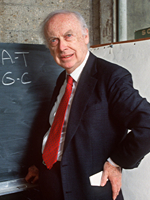James Watson

Adapted and shortened from the Washington Post obituary.
James D. Watson, the American molecular biologist whose discovery of the double-helix structure of DNA transformed biology and medicine, died November 6 at a hospice in East Northport, New York. He was 97. His death was confirmed by Cold Spring Harbor Laboratory, where he spent most of his career.
Watson, along with Francis Crick, revealed in 1953 that DNA is composed of two intertwined strands carrying the genetic instructions for life—a finding often regarded as one of the greatest scientific breakthroughs of the 20th century. The discovery helped launch the modern era of molecular biology and led to advances ranging from genetic testing to the Human Genome Project, which Watson later directed at the National Institutes of Health. He also played a major role in shaping Cold Spring Harbor Laboratory into a world-leading center for genetics research.
A native of Chicago, Watson was a precocious scholar who earned his PhD at Indiana University at 22 and joined the University of Cambridge’s Cavendish Laboratory, where he met Crick. Their 1953 Nature paper on DNA’s structure earned them, along with Maurice Wilkins, the 1962 Nobel Prize in Physiology or Medicine.
Watson’s career, however, was overshadowed in later decades by repeated racist and sexist remarks that alienated much of the scientific community. His assertions about links between race, intelligence, and genetics, as well as disparaging comments about women, led to his removal from leadership at Cold Spring Harbor and public repudiation by many former colleagues.
Watson is survived by his wife, Elizabeth Lewis Watson, whom he married in 1968; their sons, Duncan and Rufus; and a grandson. His scientific achievements revolutionized our understanding of life’s molecular foundations, even as his later views left a complicated and controversial legacy.
Read more in articles from the Washington Post and Cold Spring Harbor Laboratory.





















